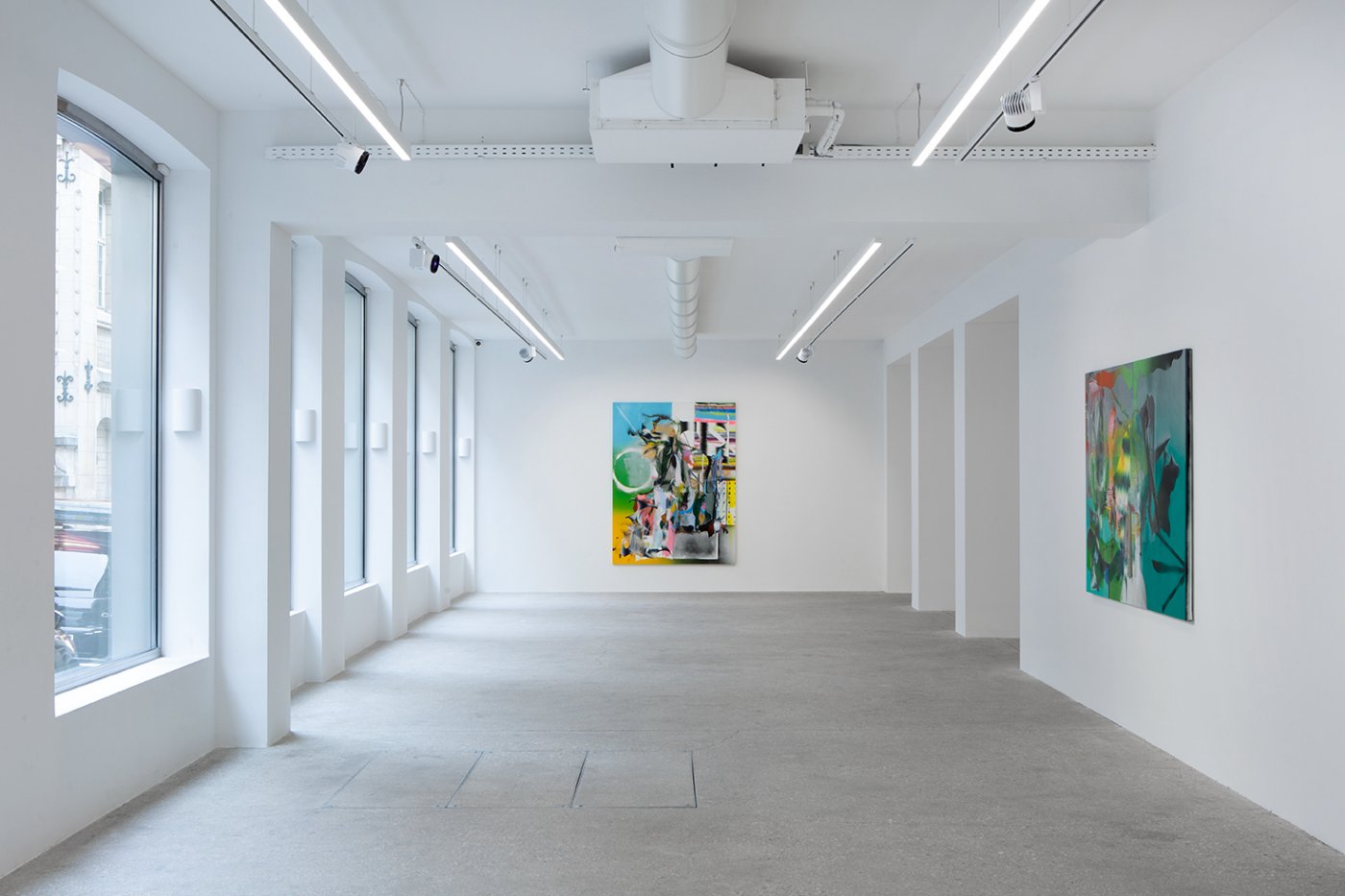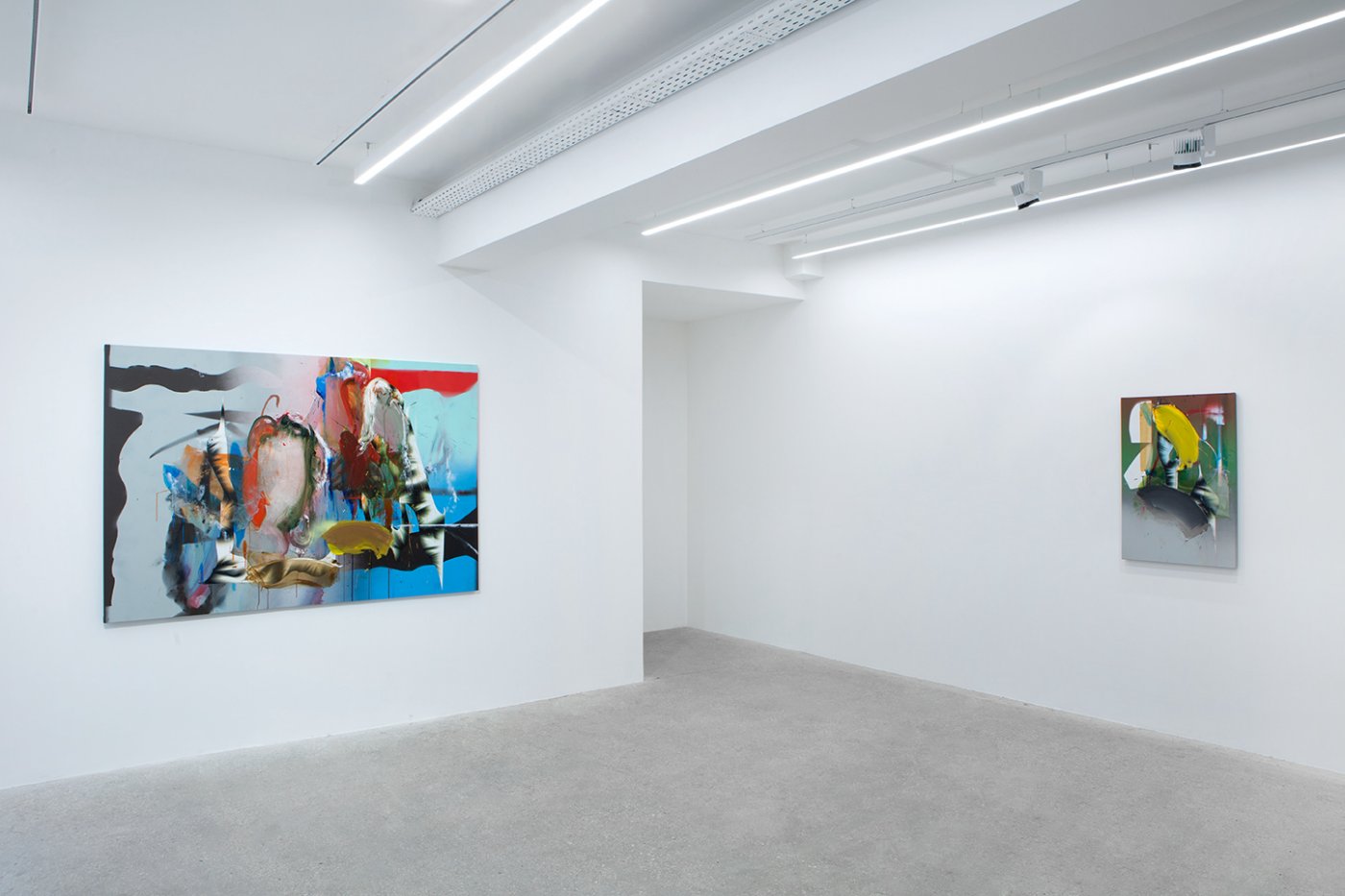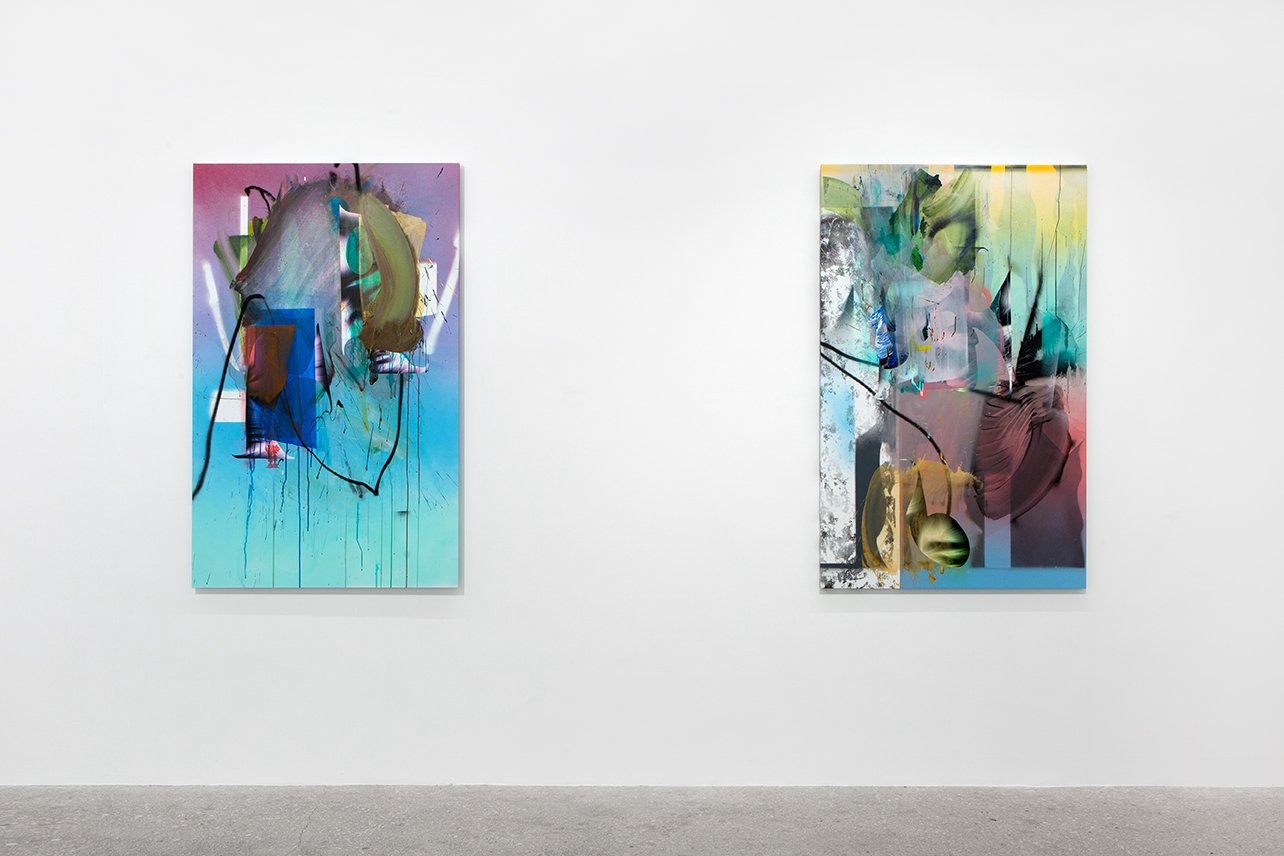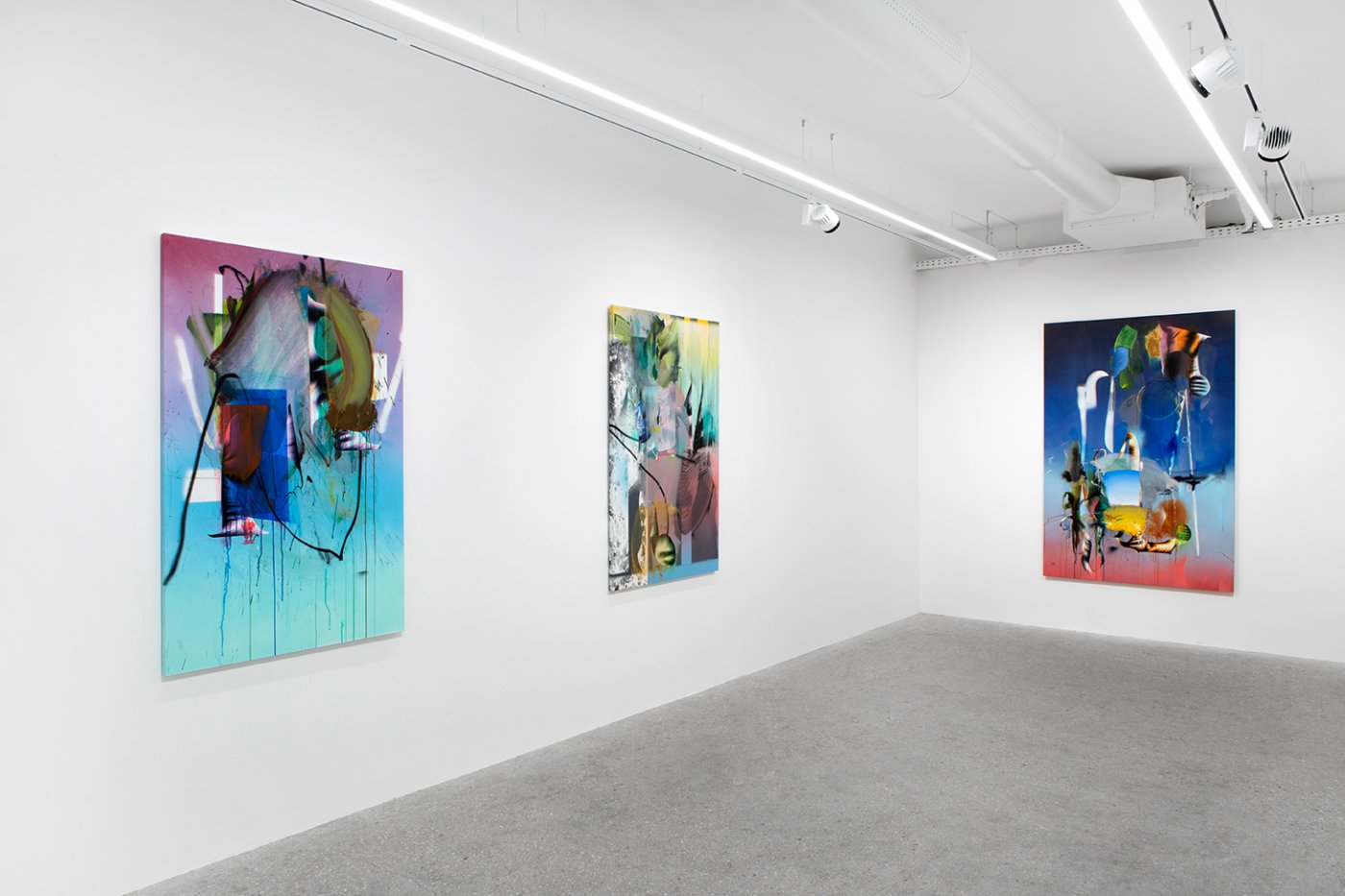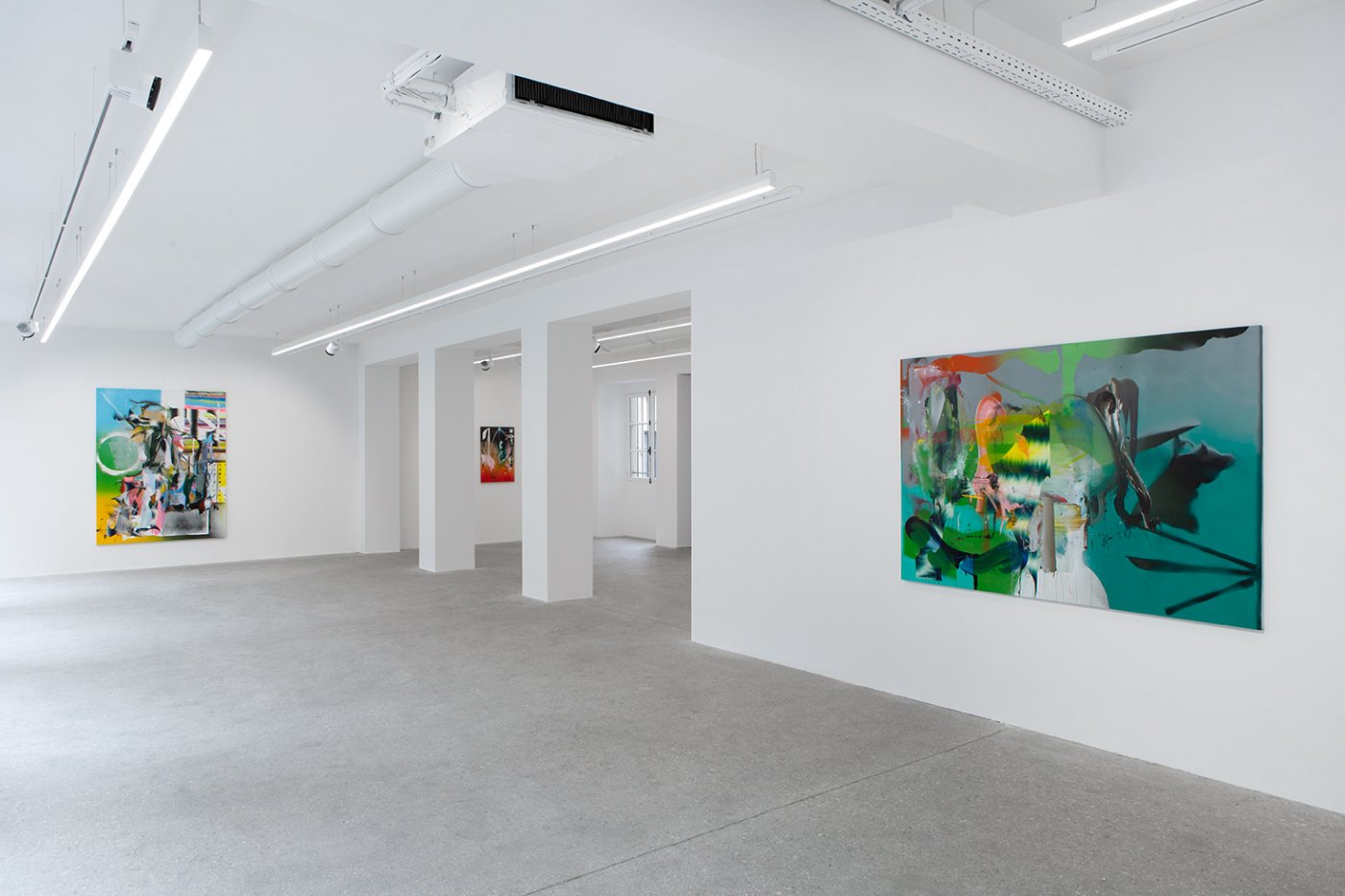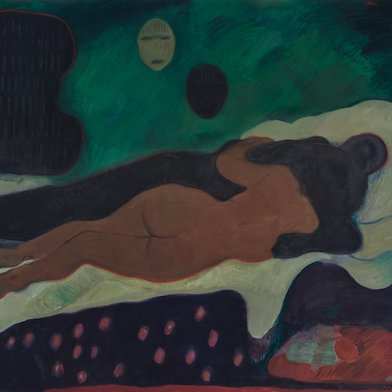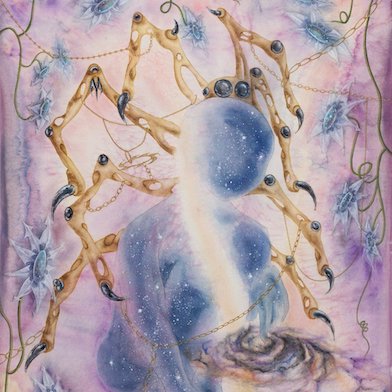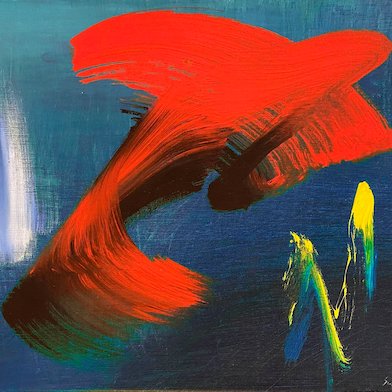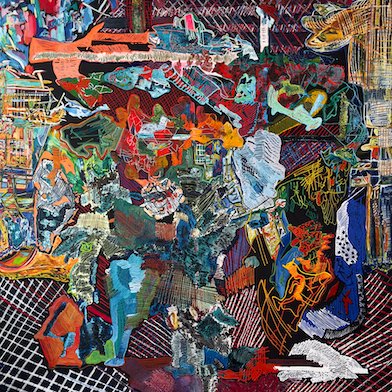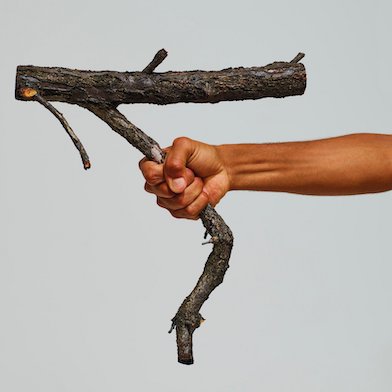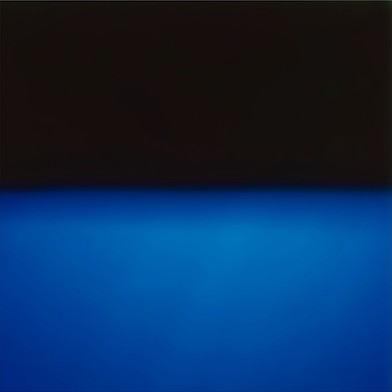Open: Tue-Sat 11am-7pm
Visit
Liam Everett: The sun is their drum
Mennour, 5 r. du Pont de Lodi, Paris
Fri 3 Feb 2023 to Sat 18 Mar 2023
5 rue du Pont de Lodi, 75006 Liam Everett: The sun is their drum
Tue-Sat 11am-7pm
Artist: Liam Everett
What do you have, Liam Everett asked me recently, when the world falls away? When the ground, the sky, the trees, your home, the chair you’re sitting on, the table before you, all of it, when it all ceases to exist? Not nothing – never nothing – but space, at least. Expansive space. And possibility.
Into that space something else can emerge.
Everett was talking about meditation, and his own daily practice of clearing psychic and imaginative space. But he was also talking about painting, and how and why his work ends up looking the way it does. His paintings, which I find uncomfortable, discordant, glitchy, restless, and permanently unresolved, are certainly not meditative, not in the usual sense of that word. They do not bring me calm; quite the opposite: They light a fire behind my eyes, and in my mind. They demand that I look closer, and be more attentive to what – and how – I am perceiving. They are hard work. And they are rewarding.
Everett has said that “Art should be about nothing,” an idea, to me, more obstinately challenging than the commonplace, moralistic assertion of art’s responsibility to mean something, of its duty of service to social and political efficacy. Everett’s convictions are not politically derived, but philosophical: he is not interested in manifesting pre-existing ideas, formulated through language. Instead, he wants his art to forge a path into an otherwise inaccessible realm of phenomenological wilderness. “It should be an encounter with a U.F.O., an unknown object you have to work out how to come to terms with.”
But nothing comes from nothing. A few years ago, Everett told me, he became uncomfortably aware of how his every mark, his every gesture, was mediated by the constant flow of stimulation around him. Learned language structures (virtually) all knowledge, and culture is threaded, like an invisible mycelium, around everything we can see or imagine. Everett considers this the “noise” he aims to silence in order to make his art. That is an impossible aspiration, he knows; “It will always be there, because no human can be human without the other. I can’t erase that.”
This aim might seem to be at odds with another intention he has for his work: to ground it in its time and place. Everett believes that such a grounding is a necessary constraint that allows for other embodiments of freedom and spontaneity to arise. In the case of the eleven new paintings in “the sun is their drum”, these conditions are incorporated into their very form. Completed beneath the slanting Pacific light of winter 2022, when travelling across the Atlantic they take something of their birthplace with them. The title for this exhibition is based on the idea that ultraviolet light arrives via an infinitely complex system of reflection, refraction, vibration and collision (including with the Moon), all of which, Everett says, “generates a kind of rhythm that hypnotizes not just our experience of seeing but our general state of awareness.”
Everett lives with his family in rural northern California, close by a forest and not far from the ocean, and he works in a converted barn. When he moved into the space, he found all manner of tools that had been abandoned by the previous owner: saws, knives, axes, buckets, garbage cans, and other metalwork. He still regularly unearths such objects when digging his land. As with previous bodies of work, made in other studios that harboured different abandoned objects, here Everett arranges these items on his canvas and uses them as compositional devices, often misting ink or paint over them to reveal their silhouettes. He uses earth, dust and sand in a similar way, scattering it onto unstretched canvases placed on the floor. While his work clearly engages with the history of abstract painting, Everett does not think of it as abstract, but as almost painfully literal.
Titles, too, locate the paintings in the world of language, even if Everett insists that the words he appends to particular paintings have nothing to do with the external qualities of the work. To distinguish between one painting and another is mainly a practical convenience, he says. “I really see them all as different parts of the same process.”
In earlier bodies of work, Everett focused our attention on the performative aspects of making a painting, and, through his installations, often referenced the world of theatre. Perhaps in response to his withdrawal to the remote countryside, or perhaps because of the isolating constraints of the pandemic, with this new work he tends to think in terms of solo improvisation. He talks of the “state of ecstasy” into which he enters – or strives to enter – when making his paintings. In this state, conscious thought can be suspended, language can be quietened, intention can be forgotten and, in that place of freedom, new visions can be ushered into being.
— Jonathan Griffin
—
Born in 1973 in Rochester, New York, LIAM EVERETT lives and works in Northern California.
His work has been included in exhibitions at the San Francisco Museum of Modern Art; the Biennale of Painting, Museum Dhondt-Dhaenens, Deurle, Belgium; U.C. Berkeley Art Museum and Pacific Film Archive; San Jose Institute of Contemporary Art; CCA Wattis Institute for Contemporary Arts, San Francisco. Everett is the recipient of the SECA Art Award at the San Francisco Museum of Modern Art (2017), the Richard Diebenkorn Teaching Fellowship at the San Francisco Art Institute (2013) and the San Francisco Artadia Award (2013). Everett’s work is included in significant international public collections, including the Metropolitan Museum of Art, New York; San Francisco Museum of Modern Art; Dallas Museum of Art; Musée des Beaux-Arts, Rennes, France; Fondation Carmignac, Paris; Kistefos Museum, Jevnaker, Norway, and U.C. Berkeley Art Museum and Pacific Film Archive.
Qu’est-ce qu’il te reste, me demanda récemment Liam Everett, quand le monde autour de toi s’estompe ? Quand la terre, le ciel, les arbres, ta maison, la chaise sur laquelle tu es assis, la table devant toi, tout ce qui t’entoure, quand tout cela cesse d’exister ? Non pas rien– il ne te reste jamais « rien »– mais l'espace, tout au moins. Un espace en expansion. Et des possibilités.
Dans cet espace, quelque chose d’autre peut émerger.
Liam Everett parlait de méditation, et de sa pratique quotidienne pour vider son espace mental et créatif. Mais il parlait aussi de peinture, du comment et du pourquoi son travail finit par avoir l’aspect qui est le sien. Ses peintures, que je trouve inconfortables, discordantes, problématiques, agitées et perpétuellement en suspens, ne sont certainement pas méditatives, du moins pas dans le sens courant du terme. Elles ne m’apaisent pas ; c’est plutôt l’opposé : elles embrasent mes yeux et mon esprit. Elles exigent de moi que je les regarde de plus près et que je sois plus attentif à ce que je perçois – et comment je le perçois. Elles sont exigeantes. Et elles sont gratifiantes.
Liam Everett a dit que « l’art devrait être à propos de rien », une idée, selon moi, plus stimulante que l’affirmation banale et moralisatrice selon laquelle l’art a le devoir de signifier quelque chose, de servir un but social et politique. Les convictions de Liam Everett ne sont pas issues du politique mais sont plutôt philosophiques : représenter des idées préexistantes, formulées au travers du langage, ne l’intéresse pas. Au lieu de cela, il souhaite que son art ouvre une voie vers le terrain inexploré du monde phénoménologique. « Cela devrait être une rencontre avec un OVNI, un objet inconnu avec lequel il faut trouver les moyens de composer. »
Mais rien ne vient de rien. Liam Everett m’a confié qu’il y a quelques années de cela, il est devenu conscient que la moindre marque qu’il faisait, le moindre de ses gestes, était déterminé par le flot constant de stimulations autour de lui et cette réalisation l’a gêné. Le langage appris structure (pratiquement) toute connaissance, et la culture se noue, comme un mycélium invisible, autour de tout ce que l’on voit ou imagine. Liam Everett considère cela comme « le bruit » qu’il vise à réduire au silence pour produire son art. C’est une aspiration impossible, il le sait : « Ce sera toujours présent, car aucun humain ne peut être humain sans un autre. Je ne peux pas effacer cela. »
Cette ambition peut paraître aux antipodes d’une autre intention qu’il met à son travail : l’ancrer dans son espace et son temps. Liam Everett est convaincu qu’un tel ancrage est une contrainte nécessaire pour permettre à d’autres incarnations de liberté et de spontanéité d’émerger. Dans le cas des onze nouvelles peintures réalisées pour “the sun is their drum”, ces contraintes sont intégrées dans la forme même des œuvres. Achevés sous la lumière oblique du Pacifique à l’hiver 2022, quand ils voyagent de l’autre côté de l’Atlantique ses tableaux emportent avec eux quelque chose de leur lieu de création. Le titre de cette exposition est fondé sur l’idée que la lumière ultraviolette nous parvient à travers un système infiniment complexe de réflexion, réfraction, vibration et collision (y compris avec la Lune), et que tout cela, selon Liam Everett, « génère une sorte de rythme qui hypnotise non seulement la façon dont on voit le monde mais aussi notre état de conscience général. »
Liam Everett vit avec sa famille à la campagne, au nord de la Californie, près d’une forêt et non loin de l’océan, et il travaille dans une grange réhabilitée. Quand il s’est installé dans cet espace, il a trouvé toutes sortes d’outils qui avaient été abandonnés par le propriétaire précédent : des scies, des couteaux, des haches, des seaux, des poubelles, et d’autres outils en métal. Il continue d’en déterrer régulièrement lorsqu’il travaille sa terre. Tout comme pour des séries d’œuvres précédentes, réalisées dans d’autres ateliers qui recélaient autant d’objets abandonnés, Liam Everett dispose ces éléments sur ses toiles et les utilise comme supports de composition, les vaporisant d’encre ou de peinture pour révéler leurs contours. Il utilise de la terre, de la poussière et du sable de manière similaire, saupoudrant ses toiles encore non tendues posées au sol. Bien que son travail dialogue clairement avec l’histoire de la peinture abstraite, Liam Everett ne le considère pas abstrait, mais presque cruellement littéral.
Les titres, eux aussi, situent les peintures dans le monde du langage, même si Liam Everett insiste sur le fait que les mots qu’il appose à des tableaux donnés n’ont rien à voir avec leurs qualités extrinsèques. Distinguer un tableau d’un autre relève surtout d’un aspect pratique, dit-il. « Je les vois vraiment tous comme différentes parties d’un même processus. »
Dans des séries de travaux antérieurs, Liam Everett a attiré notre attention sur les aspects performatifs de la pratique picturale, et, à travers ses installations, a souvent fait référence au monde du théâtre. Est-ce en écho à sa retraite dans une campagne reculée, ou aux contraintes d’isolement imposées par la pandémie, que Liam Everett tend à nouvellement envisager son travail comme une improvisation en solo ? Il parle de « l’état d’extase » dans lequel il entre – ou aspire à entrer – quand il réalise ses peintures. Dans cet état, la pensée consciente peut être suspendue, le langage peut être assourdi, l’intention peut être oubliée et, dans cet espace de liberté, de nouvelles visions peuvent voir le jour.
— Jonathan Griffin
—
Né en 1973 à Rochester, New York, LIAM EVERETT vit et travaille au nord de la Californie.
Ses œuvres ont fait partie d’expositions au San Francisco Museum of Modern Art ; à la Biennale of Painting, Museum Dhondt-Dhaenens, Deurle, Belgique ; U.C. Berkeley Art Museum and Pacific Film Archive ; San Jose Institute of Contemporary Art ; CCA Wattis Institute for Contemporary Arts, San Francisco. Liam Everett a reçu le SECA Art Award au San Francisco Museum of Modern Art (2017), le Richard Diebenkorn Teaching Fellowship au San Francisco Art Institute (2013) et le San Francisco Artadia Award (2013). Ses œuvres font parties d’importantes collections publiques internationales, telles que celles du Metropolitan Museum of Art, New York ; San Francisco Museum of Modern Art ; Dallas Museum of Art ; Musée des Beaux-Arts, Rennes, France ; Fondation Carmignac, Paris ; Kistefos Museum, Jevnaker, Norvège et U.C. Berkeley Art Museum and Pacific Film Archive. Exhibition views « Liam Everett, the sun is their drum », Mennour (5 rue du Pont de Lodi, Paris 6), 2023 © Liam Everett. Photo. Archives Mennour. Courtesy the artist and Mennour, Paris
